p.3
p.11
p.17
p.23
p.29
p.35
p.43
p.51
Correlation of Extended Defects with Electrical Yield of SiC MOSFET Devices
Abstract:
The quality of the silicon carbide (SiC) epitaxial layer, i.e., layer homogeneities and extended defect densities, is of highest importance for high power 4H-SiC trench metal-oxide-semiconductor field effect transistors (Trench-MOSFET) devices. Especially, yield for devices with a large chip area is severely impacted by extended defects. Previously, devices had to be fully manufactured to effectively gauge the impact of a reduction in extended defect densities in the epitaxial layers on device yield. The production of devices such as Trench-MOSFETs is an extensive procedure. Therefore, a correlation between extended defects in the epitaxial layer and electrical device failure would allow to reliably estimate the impact of process changes during epitaxial layer deposition on electrical device yield.For this reason, n-type epitaxial layers were grown on around 1,000 commercially available 150 mm 4H-SiC Si-face substrates, which received a chemical wet cleaning prior to the epitaxy deposition. Substrates with lowest micro-pipe density from two different suppliers were used. The wafers were characterized with the corresponding device layout for defects utilizing surface microscopy as well as ultraviolet photoluminescence techniques. Subsequently, these wafers were used to produce more than 500,000 Trench-MOSFET devices. All devices have been tested on wafer level for their initial electrical integrity.With these methods a precise correlation between extended defects in the epitaxial layer and electrical failures on wafer level could be found. The influence of different substrates on the defect-based yield prediction regarding the electrical yield on wafer level is discussed. Additionally, a calculated kill-ratio is presented and the severity of defect classes on initial device failure, e.g., stacking faults, and their key failures modes are discussed.
Info:
Periodical:
Pages:
11-16
Citation:
Online since:
June 2023
Authors:
Permissions:
Share:
Citation:



